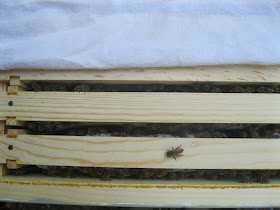I'm heading for Young Harris tomorrow so I stopped by Stonehurst Place today to check on the bees. I thought there was a slight chance they might need another box. I added a super to each hive on Monday, the 1st, and even though that was just about a week ago, we are in the middle of a nectar flow.
Both hives had good activity going in and out of the hives when I got there.
Hive one had nice white new honey comb in the second box but had not started making comb in the third box. I checkerboarded some of the comb from box 2 to box 3 to encourage them. I didn't move a lot of the comb because the queen is laying in the second box and there was some brood on the frames as well.
In the second hive at Stonehurst, the bees peeked up at me from box three between well-filled combs. They had already filled every frame but one with comb and honey.
Here is some of their beautiful honey. I expect the guests at Stonehurst will get to eat some of this as cut comb honey if the owner is open to that idea.
The cappings are just gorgeous!!
In the second super in this hive there was also brood. This is a busy queen and a good, growing hive.
More brood. I checkerboarded the frames in boxes three and four to increase the bees interest in box four. In the process I had to cut off some honey-dripping comb so Jim, the inn-sitter while Caroline and Gary are away, and I tasted the first taste of their honey - really light and DELICIOUS.
I added a fourth box to this hive and put bottle tops on the inner cover corners of both hives to add to ventilation. I thought we ordered slatted racks for these hives, but we don't have them.
Funny that two hives started at the same time could be in two different places. The bees in hive two (from which Victor sampled 300 bees) are more productive than the bees so far in hive one.
Both hives had good activity going in and out of the hives when I got there.
Hive one had nice white new honey comb in the second box but had not started making comb in the third box. I checkerboarded some of the comb from box 2 to box 3 to encourage them. I didn't move a lot of the comb because the queen is laying in the second box and there was some brood on the frames as well.
In the second hive at Stonehurst, the bees peeked up at me from box three between well-filled combs. They had already filled every frame but one with comb and honey.
Here is some of their beautiful honey. I expect the guests at Stonehurst will get to eat some of this as cut comb honey if the owner is open to that idea.
The cappings are just gorgeous!!
In the second super in this hive there was also brood. This is a busy queen and a good, growing hive.
More brood. I checkerboarded the frames in boxes three and four to increase the bees interest in box four. In the process I had to cut off some honey-dripping comb so Jim, the inn-sitter while Caroline and Gary are away, and I tasted the first taste of their honey - really light and DELICIOUS.
I added a fourth box to this hive and put bottle tops on the inner cover corners of both hives to add to ventilation. I thought we ordered slatted racks for these hives, but we don't have them.
Funny that two hives started at the same time could be in two different places. The bees in hive two (from which Victor sampled 300 bees) are more productive than the bees so far in hive one.








Hi, Linda!
ReplyDeleteYou're right-- that capped honey looks wonderful. Maybe this will be your record honey year as it's off to a great start.
As you noted, sometimes there's no way to know why some hives take off & others don't, though beekeepers too often blame the queen. Just a thought: I wondered if the stronger hive is getting the benefit of drift because they are so close, even though you've put orientation marks on the fronts. If you angled the entrances slightly away from each other (about 20 degrees or so) that might eliminate drift if there is any. I don't know that the difference would be noticeable, though, after the burst of spring growth and the frenzy of the nectar flow.
You should really enjoy the satisfaction of starting off these new colonies on a happy path! Congratulations.
Penny
Could you discuss what the arrows on the tops of frames mean? And I'm also curious about the yellow sticker-looking things on the fronts of hives. Are they for bee-orientation?
ReplyDeleteThanks again for keeping this fascinating blog. We're entering our second year of beekeeping in the San Francisco Bay Area. We've learned a lot, and there's so much yet to learn!
The arrows on the tops of the frames are for Housel positioning. There's a post on this blog about what that is - too complicated to explain here. Although the research is mixed, Michael Housel determined that the bees in the wild build their comb this way, so I try to orient my starter strip frames or drawn comb in that way - supposed to make the bees build the comb bigger and more comfortably.
ReplyDeleteThe yellow stickers are to help control drift. The bees orient to their hives and with something distinctive on the front of their hive, the thinking is that they are more likely to come "home" than to drift to the other hive.
http://beekeeperlinda.blogspot.com/2006/05/housel-positioning-for-honey-super.html
ReplyDelete